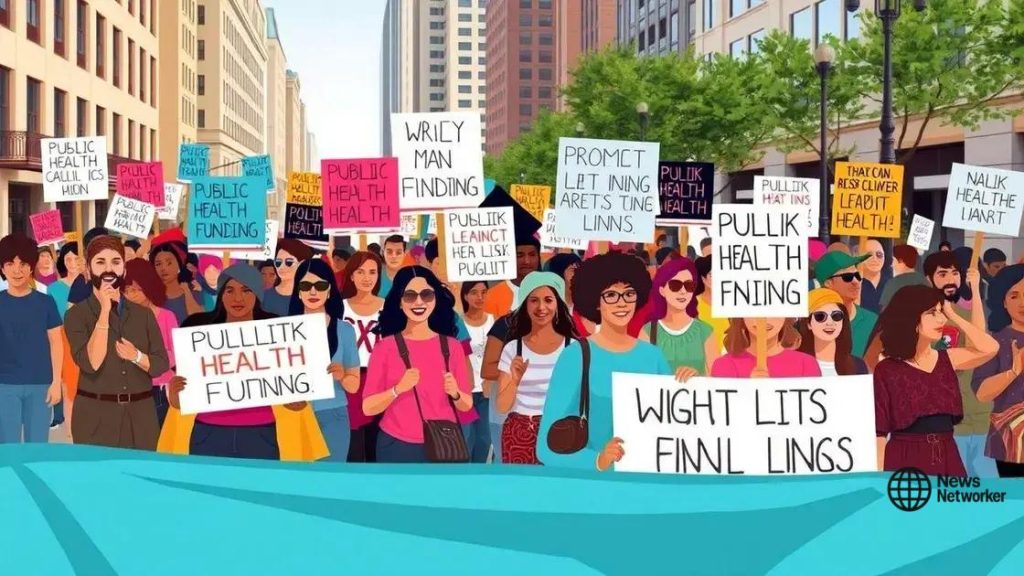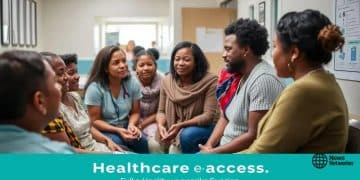Marches for public health funding: why they matter

Public health funding initiatives are essential for improving community health through preventive care, data-driven strategies, and community involvement, enabling better resource allocation and addressing health disparities.
Marches for public health funding have become a powerful way for communities to advocate for better health resources. Have you ever wondered how these movements influence real change? Let’s explore their impact.
The significance of public health funding
The significance of public health funding cannot be understated. It plays a crucial role in the health of entire communities. Without adequate funding, essential health services may falter, leading to increased illness and health disparities.
Public health funding supports various programs that promote disease prevention, health education, and access to medical care. These programs can make a significant difference in how communities manage health crises.
Key areas benefiting from public health funding
Funding is vital for the following areas:
- Immunization programs: They protect against infectious diseases.
- Health education: Programs that inform communities about healthy lifestyles.
- Emergency preparedness: Ensuring communities can respond effectively to health threats.
- Chronic disease prevention: Initiatives that help reduce the incidence of diseases like diabetes and heart disease.
Effective public health funding also addresses social determinants of health. This means looking at factors like income, education, and environment. When these elements are considered, the overall health of the community improves.
Additionally, during health emergencies, swift funding can make the difference between life and death. For instance, rapid responses to outbreaks can save lives and resources if public health systems are well-funded and prepared.
In conclusion, the significance of public health funding is clear. It helps ensure a healthier future for all, supporting initiatives that address not just immediate health needs but also long-term wellness for communities.
Key issues highlighted in recent marches
Key issues highlighted in recent marches have brought vital concerns to the forefront of public health discussions. The voices of community members are echoing through the streets, urging leaders to pay attention to significant health disparities.
One prominent issue is access to healthcare. Many participants emphasize the need for affordable and comprehensive health services. This access is not just a privilege but a right for every individual.
Major themes expressed in the marches
During these events, several themes consistently emerge:
- Equity in health services: Advocates demand equal access for all, regardless of income or background.
- Investments in mental health: There is a growing call for more funding and resources dedicated to mental health services.
- Support for vulnerable populations: Marginalized groups, such as low-income families and racial minorities, require additional support.
- Preventative care: Emphasis on the importance of funding for programs that prevent illnesses before they require more extensive treatment.
Further, environmental factors are often linked to health outcomes. Marchers seek more action on clean air and water, recognizing that a healthy environment contributes to a healthy community.
Moreover, issues related to public health funding are central to discussions at these marches. Community members advocate for increased funding to enhance public health infrastructure. They believe that better funding will lead to more effective health programs and improved overall health metrics.
To summarize, the key issues highlighted in recent marches reflect the urgent need for systemic change. By addressing these concerns, communities aim to create a healthier and fairer world for everyone.
Community stories from the front lines

Community stories from the front lines provide a powerful insight into the real impact of public health initiatives. These personal narratives reflect the challenges and triumphs faced by individuals working to improve health outcomes in their neighborhoods.
One compelling story comes from a community health worker who has dedicated years to fighting for better access to healthcare in underserved areas. Their firsthand experience reveals how vital funds can transform services, allowing clinics to expand hours and provide necessary resources.
Real-life examples of impact
Stories often highlight key areas where change has been most evident:
- Access to vaccinations: Many community members share how mobile clinics helped increase vaccination rates among children.
- Health education initiatives: Programs that teach families about nutrition have seen success, resulting in healthier lifestyles.
- Mental health support: Stories of individuals who found help through local programs emphasize the importance of mental health awareness.
- Emergency response training: Community members getting involved in trainings have become essential in managing health crises.
These narratives not only show the progress made but also the struggles that continue. For instance, some stories discuss the barriers to mental health resources, shedding light on the need for further investment in these areas. The resilience and hope demonstrated by these individuals drive others to participate and advocate for change.
Additionally, the connections fostered through these programs often create a sense of community. People come together to support one another, sharing resources and knowledge. Community engagement has proven to be a crucial element in addressing public health challenges effectively.
Finally, these stories from the front lines highlight the ongoing need for public health funding. They remind us that every dollar matters and can have a profound effect on lives within communities. By listening to these voices, we gain a deeper understanding of what is at stake.
How to get involved in public health advocacy
How to get involved in public health advocacy is an important question for many individuals looking to make a difference. Engaging in public health advocacy can begin with small, meaningful actions that collectively have a great impact.
One effective way to start is by educating yourself about local public health issues. Knowledge empowers individuals to speak out and promote change. Attend community meetings, read relevant articles, and connect with local health organizations to stay informed.
Steps to participate in advocacy
Consider the following steps to get involved:
- Join local advocacy groups: Find organizations working on health issues you are passionate about.
- Volunteer your time: Many groups need volunteers for events, campaigns, or educational programs.
- Engage with policymakers: Contact your local representatives to express your concerns and suggest public health improvements.
- Participate in marches and rallies: Show your support and raise awareness by joining public demonstrations advocating for health funding.
Moreover, using social media can amplify your voice. Share information, articles, and your personal insights on public health matters. Engaging with like-minded individuals online can create a supportive network.
Additionally, consider becoming a certified advocate. Training programs often exist that can equip you with the necessary skills to promote public health effectively. These programs help you learn how to communicate your message clearly and persuasively.
Lastly, never underestimate the power of community involvement. Start small by organizing discussions in your neighborhood about local health challenges. Bringing people together to discuss solutions fosters a greater sense of collective responsibility.
Public health advocacy is an ongoing journey, and every action counts. By taking the steps outlined above, you can play a vital role in improving health in your community.
Future of public health funding initiatives
The future of public health funding initiatives is increasingly important as communities face new challenges. With advancements in technology and changing health landscapes, funding strategies must evolve.
One significant aspect is the shift towards a data-driven approach. By utilizing data analytics, organizations can identify health trends and allocate resources more efficiently. This means funding can be directed to areas of greatest need, making a real impact on community health outcomes.
Emerging trends in funding
Several trends are shaping public health funding initiatives:
- Increased collaboration: Partnerships between government agencies, non-profits, and private sectors are on the rise. Collaborative funding leads to innovative solutions.
- Focus on preventive care: More initiatives are being launched to emphasize prevention. This shift helps reduce long-term healthcare costs.
- Community involvement: Engaging local communities in health initiatives has proven effective. Residents often have unique insights into their health needs.
- Technology integration: Utilizing technology for health communication and data collection is becoming common. This helps in reaching wider populations.
Moreover, diversifying funding sources remains crucial. Relying solely on government grants can be risky. Therefore, seeking out alternative funding, including private donations and crowdfunding, can provide stability and expand initiatives.
Another important factor is advocating for policy changes that support funding increases in public health. Community advocates can influence policy decisions, ensuring that public health remains a priority for lawmakers.
As we look to the future, it is clear that public health funding will require adaptability and a forward-thinking mindset. The needs of communities are constantly changing, and funding strategies must follow suit to maintain and improve health outcomes.
FAQ – Frequently Asked Questions about Public Health Funding Initiatives
What are public health funding initiatives?
Public health funding initiatives are programs designed to allocate resources for improving community health, including preventive care and health education.
How can I get involved in public health advocacy?
You can get involved by joining local advocacy groups, volunteering your time, and participating in community discussions about health issues.
Why is preventive care important in public health?
Preventive care reduces the incidence of diseases, ultimately lowering healthcare costs and improving overall community health outcomes.
What role does data play in public health funding?
Data is crucial for identifying health trends and needs, allowing for better allocation of resources and more effective health strategies.





